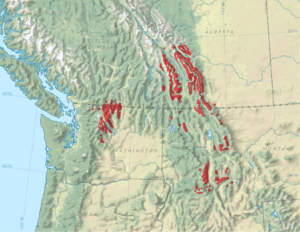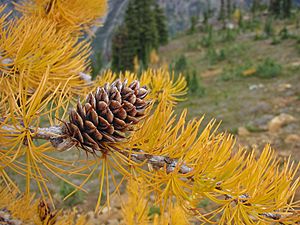Subalpine larch facts for kids
Quick facts for kids Subalpine larch |
|
|---|---|
 |
|
| Conservation status | |
| Scientific classification | |
| Genus: |
Larix
|
| Species: |
lyallii
|
 |
|
| Natural range of Larix lyallii | |
The Subalpine Larch (Larix lyallii), also called Alpine Larch, is a special kind of tree. It's a conifer, which means it has cones, but unlike most conifers, it's also deciduous. This means its needles turn golden yellow and fall off in the autumn, just like the leaves of many other trees!
This amazing tree grows in the mountains of northwestern North America. You can find it high up in the Rocky Mountains in places like Idaho, Montana, British Columbia, and Alberta. It also lives in the Cascade Range in Washington. Subalpine Larches are tough! They can survive in very cold weather and on rocky ground, often growing right near the treeline, which is the highest point where trees can still grow.
These trees usually grow at high altitudes, from about 1,800 to 2,400 meters (about 5,900 to 7,900 feet) above sea level. Even though they are hardy, they need soil that is moist but also drains water well. They can grow in different types of soil and in sunny or shady spots.
Contents
What Does the Subalpine Larch Look Like?
The Subalpine Larch is a medium-sized tree, usually growing from 10 to 25 meters (about 33 to 82 feet) tall. Trees that grow at very high elevations are often shorter. It has a straight trunk and a crown that looks a bit like a cone, but it's not very dense.
Its branches stick out straight from the trunk and are spaced unevenly. They can look a bit twisted. The small twigs are covered in fine hairs. The needles are about 20 to 35 millimeters (0.8 to 1.4 inches) long and have four sides. They grow in tight groups of 30 to 40 on short little bumps called spurs. In summer, the needles are a pale blue-green color. In autumn, they turn a beautiful golden yellow before falling off.
The cones of the Subalpine Larch are about 2.5 to 4 centimeters (1 to 1.6 inches) long. When they are young, they are a pretty red-purple color. As they get older, they turn dark brown. The cones have thin scales and narrow parts called bracts that stick out over the scales.
The bark of the tree is thin. When the tree is young, the bark is yellow-gray. As the tree gets older, it turns dark red-brown and becomes deeply grooved, forming small, scaly plates.
How Long Do They Live?
Subalpine Larches are known for living a very long time! One tree found in Kananaskis, Alberta, Canada, is thought to be around 2,000 years old. This makes it one of the oldest trees ever recorded in Canada!
How Do People Use the Subalpine Larch?
The bark of the Subalpine Larch contains a substance called tannin. Tannin is used in some industries, for example, to treat animal hides to make leather. The wood of the Subalpine Larch is very strong, heavy, and lasts a long time, making it useful for various purposes.
See also
 In Spanish: Alerce subalpino para niños
In Spanish: Alerce subalpino para niños



